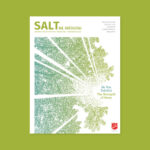
Spice Up Your Life

In one of the Bible’s most outrageous demonstrations of love, ‘a woman’ inadvertently anoints Jesus’ body for burial during a meal in Bethany. While she is mocked by those present, Jesus honours her and declares that she will be remembered throughout history for her prophetic act. Jules Badger invites us to ‘spice up our lives’ this Easter by considering the connection between this story of extravagant love and our own Easter expectations and experience.
It’s hot cross bun season! No doubt you will have noticed that the humble hot cross bun has been entirely reborn in recent years. Once just a spiced bun with fruit and a cross on top, the traditional bun has been completely transformed. Obviously, we need gluten-free buns and even fruitless ones for those among us with allergies, but the chocolate chip hot cross bun started a revolution! The apple-cinnamon hot cross bun soon followed, with the salted caramel iteration close behind and new variations emerging every year.
Clearly, we’ve strayed a long way from the humble origins of this iconic Easter treat. It’s believed that the first hot cross buns were made in the fourth century by a monk named Brother Thomas Rodcliff at St Albans Abbey in England. Brother Thomas is said to have baked the buns and distributed them to the poor on Good Friday, likely to feed empty tums, but also to share about Jesus. With the cross on the top symbolising the crucifixion, the spices within the bun representing the spices used to embalm Jesus’ body after his death, and the overall sweet deliciousness of the bun proclaiming the joy of the resurrection, who could refuse the lesson?
Spice boys
Brother Thomas’s idea gained traction and we are still enjoying various versions of his original recipe over 1000 years later. However, our hot cross bun experience in the 21st century tends to be more of an Easter indulgence eaten with lashings of real butter at home, or after church with a cuppa. The three-fold evangelistic message Brother Thomas likely intended the bun to prompt has essentially been forgotten. And while Brother Thomas was quite the innovator, he was not the original ‘spice boy’.
In John 19:38–42, we read that Joseph of Arimathea and Nicodemus were the two responsible for getting permission from Pilate to take down Jesus’ body from the cross and prepare it for burial. John records that Nicodemus ‘brought with him 75 pounds [or 34kgs] of perfumed ointment made from myrrh and aloes. Following the Jewish burial custom, they wrapped Jesus’ body with the spices in long sheets of linen cloth.’
Sometimes we forget that these two men were both cautious followers of Jesus while he was alive. John refers to Joseph as ‘a secret disciple of Jesus (because he feared the Jewish leaders)’. And we know that Nicodemus met with Jesus under the cover of darkness. Following the cross though, the love and loyalty these two spice boys display for Jesus is out in the open. And it was costly; 34kgs of spices was more than the body weight of an average man in those days. Scholars suggest that this number of spices was highly extravagant, the value being comparable to $200,000 today.
Scholars speculate that perhaps they wanted to compensate for the lack of time to anoint the body properly before the Sabbath began. Others wonder if they were acting on their hope that Jesus would be resurrected just as he said he would, wanting to preserve the body at any cost. Either way, these initially timid followers of Jesus displayed their love for him when it really mattered.
Spice girls
Most of us are familiar with the story of the women who took spices to the tomb, only to find it empty and their spices quickly forgotten. But they were not the original spice girls. Before travelling to Jerusalem and his death, we know that Jesus was anointed at Bethany in Simon’s home by ‘a woman’ who remains nameless in both Matthew’s and Mark’s Gospels.
As this original outrageous spice girl poured an extravagant amount of perfume over Jesus’ head, the men present responded: ‘“It could have been sold for more than a year’s wages and the money given to the poor.” And they rebuked her harshly’ (Mark 14:5). But Jesus had a different perspective. In Matthew 26:10–13, Jesus says, ‘Why are you bothering this woman? She has done a beautiful thing to me. The poor you will always have with you, but you will not always have me. When she poured this perfume on my body, she did it to prepare me for burial. Truly I tell you, wherever this gospel is preached throughout the world, what she has done will also be told, in memory of her.’
Spice up your life
Easter can be a time of great celebration, but it’s also a time of deep challenge and potential opportunity. Is our response to Jesus’ sacrifice and matchless love for us shown at the cross something we keep to ourselves for fear of what others may think, like Joseph and Nicodemus? Or is our response something we just can’t keep to ourselves, like the woman of Bethany?
Maybe your family or co-workers don’t share your faith and for them Easter is nothing more than a long weekend. Maybe you get a bit of a hard time from them and so, like Joseph and Nicodemus, you keep quiet about your love for Jesus. This Easter, maybe there’s an invitation from God for you to ‘spice up your life’ and share more openly. You will likely still be mocked, just like the woman who anointed Jesus at Bethany, and yet not only did Jesus commend her, but we are still talking about her example over 2000 years later.
Don’t wait until it’s too late, like Jospeh and Nicodemus. Maybe, like Brother Thomas, the hot cross bun could be a simple tool for explaining the Easter story. And maybe, just maybe, those fancy new iterations of the once humble bun could still be useful—what better way to speak of the extravagance of Jesus’ love for us!









